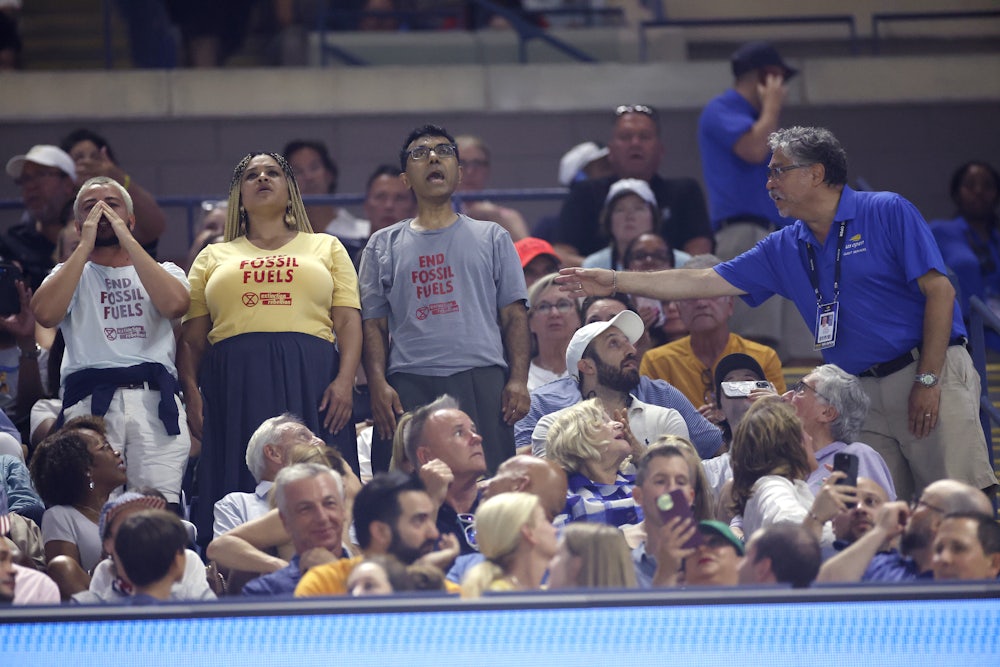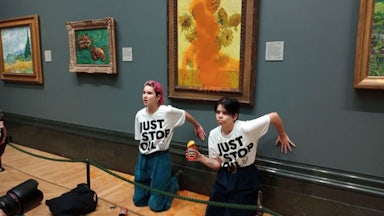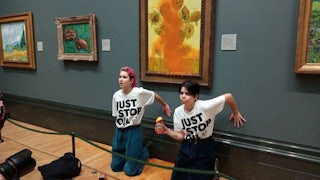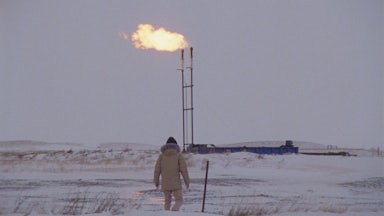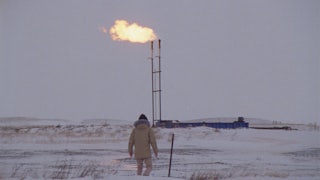This year’s U.S. Open, like every year, staged the familiar plots of sport: young phenoms emerging, champions vying to maintain supremacy, opponents strategizing, and players battling the limitations of their bodies and minds. Yet this year, and the past few years, a faceless influence has been imposing itself on the plots of Grand Slams and their heroes and villains.
Heat, aggravated by climate change, now asserts itself on the rhythms and outcomes of tennis matches more frequently than ever—especially in the humid ends-of-summer at the U.S. Open. According to the Associated Press, in the past 45 years the maximum temperatures at Grand Slams have increased by five degrees. In 2018, Roger Federer, the maestro who (it has been said) rarely lets a drop of sweat roll from his brow to his chin, labored to reach balls, abandoned rallies with drop shots, doubled over in his chair, and appeared drenched in a shirt he needed to change in his unexpected loss. Over the past few years at the U.S. Open, especially on changeovers during the day, it has become common to see players wrap towels filled with bags of ice around their necks as they gasp for air.
This week, during the matches in New York, a fan collapsed in the stands from the 100-degree heat index. The third-seed men’s player, Daniil Medvedev, called for a doctor, used an inhaler, and said into a courtside camera during the match, “One player is gonna die, and they’re [tournament organizers] gonna see.” Until Medvedev’s warning comes true—until we watch a professional tennis player collapse and die on the court—it’s likely that the heat will merely be mentioned by tennis commentators as a “condition,” like the speed of the courts or the strength of the wind, that players must overcome to succeed.
Yet on Thursday night, in what has become a common twist at major tennis tournaments, fans protesting inaction on the climate crisis halted the play in Arthur Ashe Stadium. Three people in the upper level of the stadium wearing “END FOSSIL FUELS” shirts disrupted the drama on the court—the first of the women’s semifinals that evening—by standing and screaming, at the tops of their lungs, to “stop climate change now.” Players waited as security escorted the protesters out of the stadium. Yet one of the protesters, who glued his bare feet to the ground, remained, causing a delay. The players left the court while a dozen police officers attempted to remove the man’s bare feet from the ground, ultimately freeing them with acetone. The match did not resume for more than half an hour.
The spectacle at the U.S. Open was not the first time that environmental advocates have turned to tennis tournaments for their protests. In 2022, during a men’s semifinal at the French Open, an environmental activist wearing the shirt announcing “We have 1028 days left” tied herself to the net. That fall, at the final tournament of Federer’s career, a protester wearing a shirt with the message “End UK Private Jets” sat down on court and set himself on fire.
The choice of this sport may seem curious: The National Football League and National Basketball League dominate American sports in attendance and viewership, while soccer far surpasses tennis in its global popularity. On a practical level, it is simply easier to protest at a tennis match, thanks to tennis’s inferior security and the courts’ short walls—from violent attacks to protests, it seems easier to get onto a professional tennis court than any other kind of professional playing field. Tennis might be the preferred target because the game requires silence: Any shouts, any jeers from the stands disrupt the players’ concentration and prevent play. Just one person needs to scream, and thousands notice—including the protagonists on court.
Tennis also garners many high-level sponsorships and is popular with the upper class—the elites that climate protesters seek most to target. Toward the end of his career, Federer released a statement after Twitter users, joined by Greta Thunberg, called for him to end his sponsorship with Credit Suisse, the Swiss bank that has loaned tens of billions of dollars to the fossil fuel companies. These sponsorships help players pay for commercial but also private flights across continents in a global schedule that lasts nearly the entire year. Last January, Tennis Australia suddenly canceled a sponsorship with Santos, an oil and gas company, due to environmentalists’ outrage. This summer, celebrities, including actress Emma Thompson, called for Wimbledon to cancel its deal with Barclays because the bank has provided hundreds of billions of dollars to the fossil fuel industry since the 2015 Paris accords. Wimbledon’s Center Court displays a Royal Box where celebrities and European royals watch their tennis; the U.S. Open calls its VIP seating in Arthur Ashe the President’s Box and this year hosted the former president, Barack Obama, who sat with Michelle Obama courtside. Tennis began as the sport of the royals, and, protesters recognize, it is the few with access to power who can halt the annihilation of vulnerable ecosystems, species, and people.
Is interrupting the leisure of the royals and the masses, a tennis match—in my eyes, the most poetic of all sports—the most effective way to halt the advances of climate change, which feeds on quarterly reports and the hands of politicians quick to share their routing numbers with lobbyists? After a climate protest in Washington D.C. last month, during which activists wearing “END FOSSIL FUELS” shirts threw oversize tennis balls onto the court, Taylor Fritz, the young American who went on to lose the match, said that he didn’t “understand how people are going to get behind a cause when you’re ruining everyone else’s good time.… I jokingly said, ‘Honestly, this makes me want to go fly on jets more.’” During the protest on Thursday, a commentator on ESPN speculated whether the protesting fans drank too much in the luxury suites, while a different reporter began her on-court interview with the winner by referencing the “99.99 percent that behaved themselves” during the match. As the NYPD led the man who glued himself to the floor out from the arena, fans jeered at him, cursed at him, screamed in his face. Arousing fury, but at the protesters themselves and not the oil barons: I wonder if this can truly be called a strategy for success.
Yet there appears to be something to the protests. In the half-hour delay on Thursday, broadcasters on ESPN missed an opportunity to discuss the relationship between climate change and the increasingly stifling humidity and heat—a topic of conversation so easy and necessary at the moment that it’s incredible that they dropped the proverbial ball. They could have referenced how climate change brings more heat waves and higher heat indexes and how that strains the players and alters their strategy and ability. Looking to the future, hotter conditions will make the air thinner, allowing tennis balls to fly more quickly through the air and forcing tennis players to adapt their gameplay to the higher speeds. According to research by FiveThirtyEight, the intensity of outdoor tennis might make it “sports’ first big climate casualty,” with the 2050 Australian Open projected to reach a heat index of 147 degrees. Will it even be possible to stage matches then? Or to appraise the quality of point construction as our thighs burn on the seats?
I empathize with the bitter masses: Tennis is a beautiful joy; adulthood is exhausting, frustrating, and relentless with its responsibilities and disappointments. Yet I cannot forget the repeated image of one or two or three fans standing up from tens of thousands on Thursday night to deliver monologues at the end of the world. I cannot stop thinking about how they were led out of the arena, the audience cursing and jeering, with their heads lowered or raised in defiance.
Human-caused climate change has been around for less time than tennis, but it will leave its scars on the earth for longer—much longer, millennia and millennia longer—than the outlines of our hard courts; than our fleeting forehands, backhands, and break points. The climate catastrophe is the real drama, and we are the main characters, not the audience. Seeing the silenced few led out by police through the raucous, booing masses reminds me of Marie Darrieussecq’s Sleepless, a book-length essay that describes society sleeping peacefully through decades while “the programmed destruction of wild animals” goes on. The few true insomniacs toss and turn, their blood-red eyes glow in the dark; we sleep, we sleep. “The bestiary in our books is shrinking,” she writes, “the soundtrack of our nights is fading, and we are like the characters in A Void, tormented, no longer knowing what is no longer there.”
